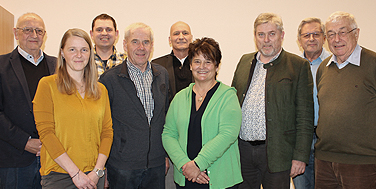On the evening of January 7th, more than a hundred Raxendorf residents filled the auditorium of the elementary school, which still smelled of fresh paint, to attend the official presentation of their Topotheque. After the welcoming words from Mayor Ing. Johannes Höfinger, Mag. Alexander Schatek explained how a Topotheque works. He highlighted how important this digital collection of photos, documents and other historical materials is to preserving local history. Afterwards, historian Prof. Gerhard Floßmann spoke about the special features of the topotheque and the history of the market town of Raxendorf.
Another highlight of the evening was the presentation of numerous functions and photos from the Topotheque. The Topothequer Bettina Futterknecht as well as Erwin Barth, Peter Stadler and Josef Auferbauer showed selected snapshots and historical photographs that provided a look at times long past. The variety of images shown – from old festivals, former department stores in the community to customs – aroused great interest and showed how important the preservation and documentation of regional history is for the community.
Here in the southern Waldviertel, elements of everyday life have been preserved for even longer than in the perhaps faster-moving communities on the major traffic arteries or in the immediate vicinity of the cities. Therefore, we can still discover first-class visual evidence from the working world that was captured with the cameras. Social history in the picture is, for example, the photograph of road construction workers from 1906: unlike today, a mixed-gender activity.
What is always striking in this era is that there was no special work clothing for earthworks. You come in an agricultural apron, shirt and gilet. The third from the left is even wearing a jacket, although he is holding a shovel. Handcarts and wooden wheel chests brought with them a fair amount of tare weight and there was of course no sign of motorized aid such as tractors or loading cranes. You can see Mr. Eggenbacher happily puffing on his pipe as he makes wooden tubs.
Anyone standing in front of their work tool today would no longer be able to explain how to use it. Here Mr. Stadler shows how the food for the animals was cut by hand.
Not only were the tasks themselves much more arduous than today, but the journey to work also had completely different dimensions for many people. Today the handicraft teacher would have to drive 8 km of winding roads, but back then she walked cross-forest every day, which was even more difficult because of the gradients, in both directions from Raxendorf to Braunegg.
So that something enjoyable comes into focus after the difficult everyday life, we indulge in the wide range of products on offer at the department store at Raxendorf 15. In 1963 the world was already a bit more luxurious. Who remembers these products?
 Opening in Raxendorf: Historiker Gerhard Floßmann, Bettina Futterknecht, Peter Stadler, Josef Auferbauer, Initiator der Topothek Alexander Schatek, Martha Auferbauer, Bürgermeister Johannes Höfinger, Erwin Barth und Johann Mark. © Municipality of Raxendorf
Opening in Raxendorf: Historiker Gerhard Floßmann, Bettina Futterknecht, Peter Stadler, Josef Auferbauer, Initiator der Topothek Alexander Schatek, Martha Auferbauer, Bürgermeister Johannes Höfinger, Erwin Barth und Johann Mark. © Municipality of Raxendorf